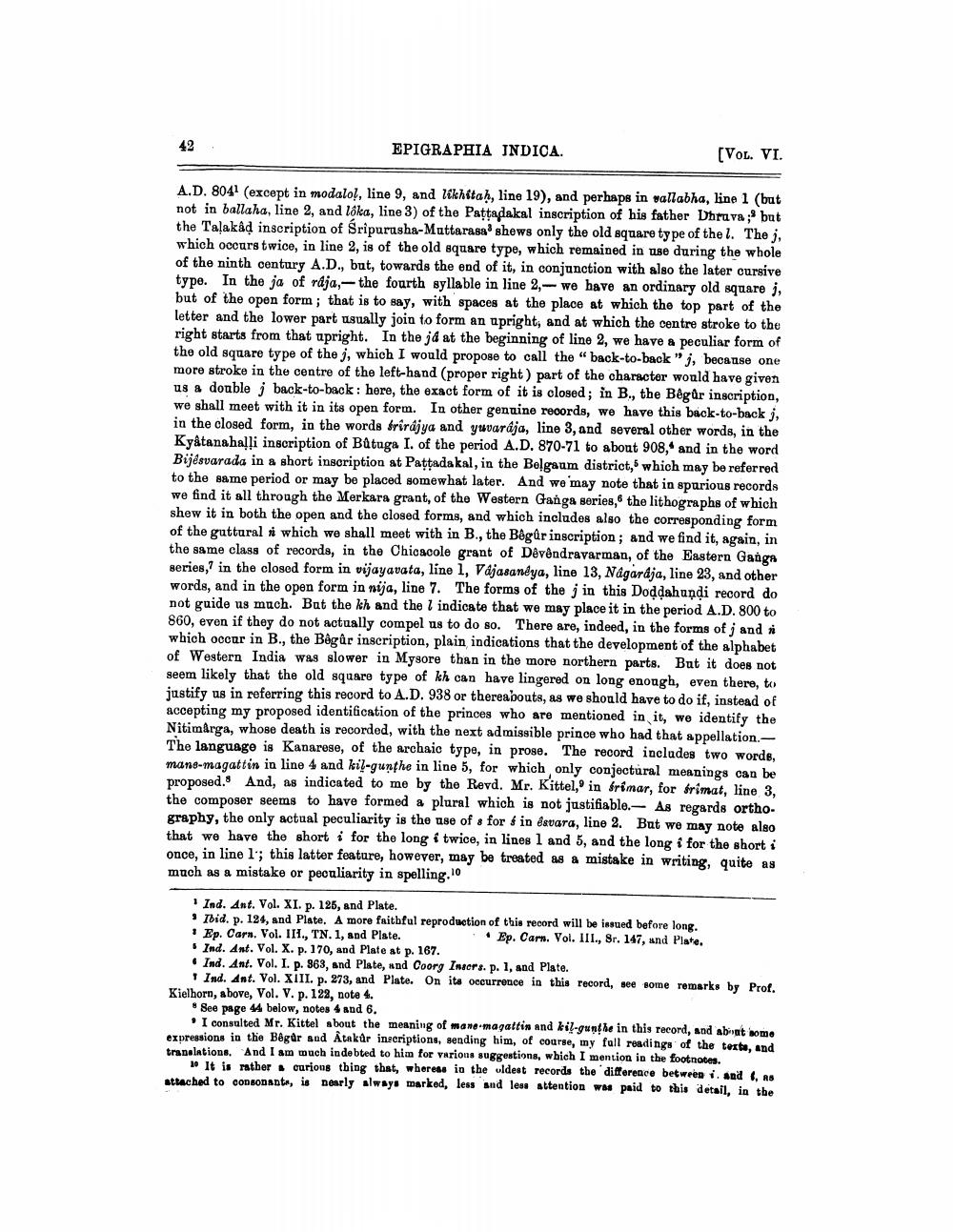________________
EPIGRAPHIA INDICA.
(VOL. VI.
A.D. 8041 (except in modalol, line 9, and likhitaḥ, line 19), and perhaps in vallabha, line 1 (but not in ballaha, line 2, and löka, line 3) of the Pattadakal inscription of his father Dhruva ;' but the Talakad inscription of Sripurusha-Mattarasa shews only the old square type of thel. Thej, which occurs twice, in line 2, is of the old square type, which remained in use during the whole of the ninth century A.D., but, towards the end of it, in conjunction with also the later cursive type. In the ja of rája,- the fourth syllable in line 2,- we have an ordinary old square j, but of the open form; that is to say, with spaces at the place at which the top part of the letter and the lower part usually join to form an upright, and at which the centre stroke to the right starts from that upright. In the jd at the beginning of line 2, we have a peculiar form of the old square type of the j, which I would propose to call the "back-to-back" j, becanse one more stroke in the centre of the left-hand (proper right) part of the character would have given us a double j back-to-back: here, the exact form of it is closed; in B., the Begür inscription, we shall meet with it in its open form. In other genuine records, we have this back-to-back j, in the closed form, in the words frirajya and yuvardja, line 3, and several other words, in the Kyậtanahalli inscription of Batuga I. of the period A.D. 870-71 to about 908, and in the word Bijesvarada in a short inscription at Pattada kal, in the Belgaum district, which may be referred to the same period or may be placed somewhat later. And we may note that in sparious records we find it all through the Merkara grant, of the Western Ganga series, the lithographs of which shew it in both the open and the closed forms, and which includes also the corresponding form of the guttural i which we shall meet with in B., the Bêgür inscription; and we find it, again, in the same class of records, in the Chicacole grant of Devendravarman, of the Eastern Ganga series, in the closed form in vijayavata, line 1, Vajasandya, line 13, Nagaraja, line 23, and other words, and in the open form in nija, line 7. The forms of the j in this Doddahundi record do not guide us much. But the kh and the l indicate that we may place it in the period A.D. 800 to 860, even if they do not actually compel us to do so. There are, indeed, in the forms of j and which occur in B., the Bêgûr inscription, plain indications that the development of the alphabet of Western India was slower in Mysore than in the more northern parts. But it does not seem likely that the old square type of kh can have lingered on long enough, even there, to justify us in referring this record to A.D. 938 or thereabouts, as we should have to do if, instead of accepting my proposed identification of the princes who are mentioned in it, we identify the Nitimarga, whose death is recorded, with the next admissible prince who had that appellation. - The language is Kanarose, of the archaic type, in prose. The record includes two words, mana-magattin in line 4 and kil-gunthe in line 5, for which only conjectural meanings can be proposed. And, as indicated to me by the Revd. Mr. Kittel, in Srimar, for frimat, line 3, the composer seems to have formed a plural which is not justifiable. As regards ortho. graphy, the only actual peculiarity is the use of 8 for fin esvara, line 2. But we may note also that we have the short for the long i twice, in lines 1 and 5, and the long i for the short i once, in line l'; this latter feature, however, may be treated as a mistake in writing, quite as much as a mistake or peculiarity in spelling,
Ind. Ant. Vol. XI. p. 125, and Plate. • Ibid. p. 124, and Plate. A more faithful reproduction of this record will be issued before long. 1 Ep. Carn, Vol. 111., TN. 1, and Plste.
Ep. Cary. Vol. III., 8r. 147, and Plate. Ind. Ant. Vol. X. p. 170, and Plate at p. 167. • Ind. Ant. Vol. I. p. 963, and Plate, and Coorg Inscrs. p. 1, and Plate.
1 Ind. Ant. Vol. XIII. p. 273, and Plate. On its occurrence in this record, see some remarks by Prof. Kielhorn, above, Vol. V. p. 122, note 4.
* See page 44 below, notes 4 and 6.
. I consulted Mr. Kittel about the meaning of mane-magattis and kil-gune in this record, and abint some expressions in the Begur sod Atakar inscriptions, sending him, of course, my fall readings of the texte, and trapolations. And I am much indebted to him for various suggestions, which I mention in the footnotes
* It is rather curious thing that, where in the uldest records the difference between 1. and AS attached to consonante, is nearly always marked, less and less attention was paid to this detail, in the




